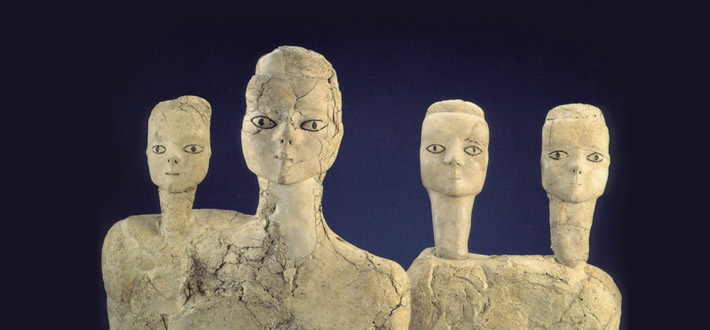
Neolithic Era:
Death and Transcendence
Statues from Ayn Ghazal, Jordan
Shamans became the specialists in transcendence and the stability of the community rested on their ability to engage the whole group by connecting it to the spirit world. How would they do this?
As Robert Wright points out his book The Evolution of God, over time a ruling partnership of sorts developed between shamans and tribal chiefs to intercede with the other world, and to control and organize the population. While still imbued with the strategies and phases of their traditional practice, shamans now began to adapt these, when possible, to accommodate this new role. They became the specialists in transcendence and the stability of the community rested on their ability to engage the whole group by connecting it to the spirit world. How would they do this? Their insight was to involve those who had gone before, with whom the group already had a strong emotional connection. Shamans in collaboration with the chiefs or elders of the group, and with an enormous commitment from the group, now called upon their dead to intercede with the spirit world on their behalf for their approbation and the subsequent success of all. For the period we know as Neolithic, the dead would be prominent in our search for meaning.
David Lewis-Williams and David Pearce examine this aspect in their book Inside the Neolithic Mind. “…the importance of the dead was that they move through the cosmos. Like the sun, they were a dynamic element, a mediating factor between levels of the cosmos. Therein lay their power and the power of those who managed to associate themselves with the dead and their cosmological travels: the dead placed the living – or rather some of the living – at the point of transition, the vortex, and thus in positions of power. The seers probably said that they were taking care of the dead, but it was actually the dead who were taking care of the seers.”
Graves were discovered at Nevali Çori, and the late German archaeologist Klaus Schmidt, who with his team led the excavations at Göbekli Tepe for over fifteen years, was reasonably confident that burials lie somewhere in the earliest layers. His team found fragments of human bone in the layers of dirt that filled the complex, which led him to suspect the pillars represent human beings and that the cult practices at this site may initially have focused on some sort of ancestor worship.
Perhaps this functioned as the burial ground for the priesthood. It is the custom of shamanic societies to bury their elders and shamans in ground already made holy or sacred by the ritual practices that had previously gone on there, even led at one time by the person buried there.
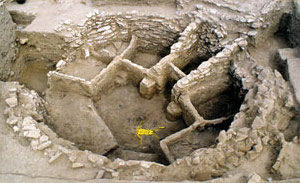
At Tell Qaramel in northern Syria, one of the oldest known settlements (ca. 11,000–9650 BCE), skulls were found either in groups or alone, some plastered with clay to recreate the face, which was then painted skin-color and placed in a specific area, presumably for veneration or at least remembrance. Bodies were buried in the flex in-utero position, perhaps ready to be born anew in the spirit world. Children who died young were buried intact, which leads scholars to think that adult brains may well have been eaten at death as a way to pass on the deceased’s essential qualities to the living.
Jericho was originally founded by sedentary foragers/collectors in the Natufian Period some 12,800–10,500 years ago. Excavations revealed sometimes up to nine human skulls buried beneath the floor of these Neolithic houses. Their faces were modeled in plaster often with inset cowrie shells for eyes and painted representations of hair and other facial features. Plastered skulls were also found at other sites, for example in Kfar HaHoresh in the Nazareth Hills of Lower Galilee in Israel and in Beidha, near Petra in Jordan.
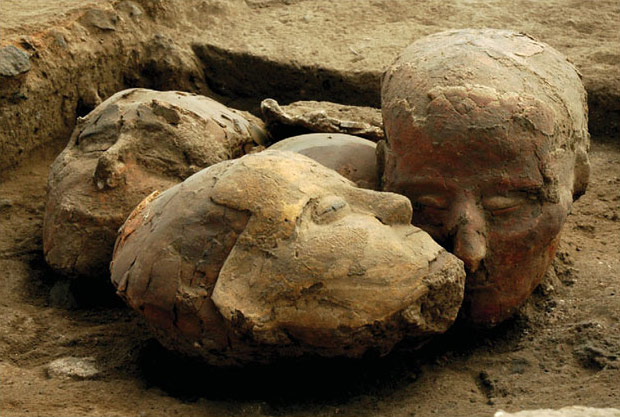
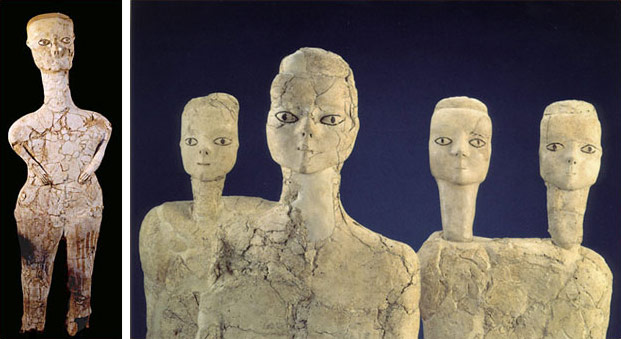
Religion Stimulates the Birth of Agriculture

Göbekli Tepe and other recently excavated sites in the Near East led scholars to question the long-standing idea of the Neolithic Revolution, invented by V. Gordon Childe in the 1920s, that agriculture, stimulated by population growth, gave rise to organized religion. Scholars surmised that the earliest monumental architecture was possible only after agriculture provided Neolithic people with food surpluses, freeing them from a constant focus on day-to-day survival. Instead, these amazing sites now lead them to conclude that the reverse was also true: the transformation to organized regional religion gave rise to farming.
After the hunter-gatherers finished building, they and others probably congregated for worship, funerals and initiations. To feed everyone they would initially have gathered and brought in wild grains and grasses. Einkorn wheat, a forerunner of domestic wheat, grows wild in the region and scholars suggest that some of the grain might well have fallen along the way as people travelled there year after year. Once it grew, it was picked and eventually became domesticated.
“Communal ceremonies come first. That pulls people together,” says Ian Hodder, an archeologist working at Çatalhöyük.
The sudden climate change of the Younger Dryas may have also forced people to come together to find new ways to produce and maintain crops of wheat and grasses. In this new agrarian world, families became larger as many hands were needed to plant, harvest crops, and take care of livestock.
It may well be that as more and more land around Göbekli Tepe was farmed to exhaustion and laid waste, this caused the site’s eventual demise. In 8000 BCE, during this shift to agriculture, Göbekli Tepe was buried. According to Klaus Schmidt this burial was done “deliberately—not in a mudslide. For some reason the hunters, or the ex-hunters, decided to entomb the entire site in soil. The earth we are removing from the stones was put here by man himself: all these hills are artificial.”
External Stories and Videos
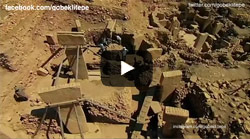
Watch: Göbekli Tepe
BBC
How did the first farmers sustain a large community and build Göbekli Tepe 12,000 years ago?
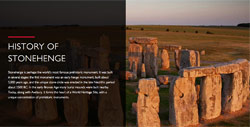
History of Stonehenge
English Heritage
Explore the history of this prehistoric monument with interactive maps of all phases of development.
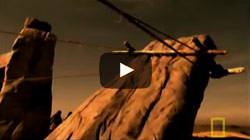
Watch: Secrets of Stonehenge
National Geographic
Many secrets remain surrounding the creation of Stonehenge. Archaeologists try to unravel the mystery.
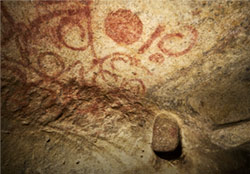
Unveiling an Underground Prehistoric Cemetery
Google Arts and Culture
A look inside Malta’s World Heritage Site, the Ħal Saflieni Hypogeum.
